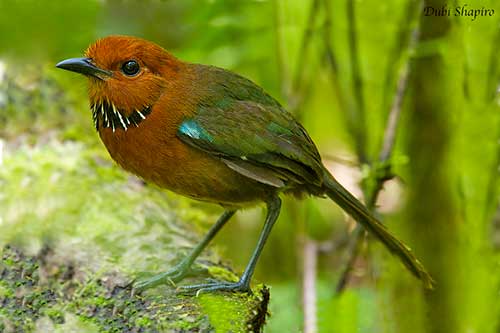
REPRODUCTION OF THIS SPECIES:
The breeding season takes place from September to February, with singing male in October/December.
The Rufous-headed Ground-Roller nests in burrow excavated in steep earth bank with overhanging vegetation. It is 30-50 centimetres long with a diameter of 15-20 centimetres. At the end there is the nest-chamber where the eggs are laid.
The female lays two eggs and probably does most of the incubation, while the male remains in the vicinity of the nest. Both parents feed the young.
PROTECTION / THREATS / STATUS:
The Rufous-headed Ground-Roller is threatened by habitat destruction through slash-and-burn cultivation and increasing hunting pressure.
This species has restricted range, but it is present in several protected areas. In addition, it seems to have a wider distribution as it has been recorded in new sites such as high mountain forests. However, it is patchily distributed.
The Rufous-headed Ground-Roller is currently listed as Near Threatened.
Fr: Brachyptérolle de Crossley
Ang: Rufous-headed Ground-Roller
All: Lätzchenerdracke
Esp: Carraca terrestre cabecirrufa
Ita: Coracia terragnola testarossiccia
Nd: Crossleys Grondscharrelaar
Sd: rödbrun markblåkråka
Mal: Voromboka, vorondreo, Vorontotra
Photographer:
Dubi Shapiro
Dubi Shapiro Photo Galleries & Dubi Shapiro's Pictures on IBC
Text by Nicole Bouglouan
Sources:
HANDBOOK OF THE BIRDS OF THE WORLD Vol 6 by Josep del Hoyo-Andrew Elliott-Jordi Sargatal - Lynx Edicions, 2001 - ISBN: 848733430X
Wildlife of Madagascar par Ken Behrens,Keith Barnes - ISBN: 140088067X, 9781400880676 – Editeur: Princeton University Press, 2016
Birds of Madagascar: A Photographic Guide Par Pete Morris, Frank Hawkins – ISBN: 0300077556, 9780300077551- Editeur: Yale University Press, 1998
The Birds of Africa: Volume VIII: The Malagasy Region: Madagascar, Seychelles, Comoros, Mascarenes - Par Roger Safford, Frank Hawkins – ISBN: 1408190494, 9781408190494- Editeur: A&C Black, 2013
Creagus - GROUND-ROLLERS Brachypteraciidae
Wikipedia, the free encyclopaedia
Rufous-headed Ground-Roller
Atelornis crossleyi
Coraciiformes Order – Brachypteraciidae Family
INTRODUCTION:
The Rufous-headed Ground-Roller is the smallest member of this family. It is endemic to Madagascar where it frequents the humid parts of the rainforest, and mainly the undisturbed, dark forest. This terrestrial species feeds on a variety of invertebrates and occasionally small chameleons. It nests in excavated burrow in steep earth bank, usually hidden by overhanging vegetation.
The Rufous-headed Ground-Roller has restricted range in E Madagascar where it is threatened by degradation of the habitat and increasing hunting pressure. It is currently listed as Near Threatened.
DESCRIPTION OF THE BIRD:
Biometrics:
Length: 24-27 cm
Weight: 73-85 g
The Rufous-headed Ground-Roller has rufous head and underparts and dark green upperparts.
The feathers of lower scapulars, rump and tertials show diffuse darker centres. We can see a bright, sky-blue and white patch on the lesser coverts. The primaries are dark brown with white bases. The tail is dark green.
On the underparts, the belly is mostly pale buffy and the vent is greenish. Black throat and upper breast are finely streaked with white.
The head is entirely rufous.
The slender bill is black, with long bristles (16 mm) around the base. The eyes are dark brown. Long legs and zygodactylous toes are blackish to dark brown.
Male and female are similar.
The juvenile is duller, with olive tinge on body and bluish-purple wash on crown and nape. The throat pattern is not well-defined and the white streaks are absent.

RANGE:
The Rufous-headed Ground-Roller occurs in the evergreen humid forest in E Madagascar, from N/NE to S.
HABITAT:
The Rufous-headed Ground-Roller is found in humid rainforest, from 800 to 2,000 metres of elevation, but more often between 1,250 and 1,750 metres.
It favours the undisturbed dark forest with moss and tall trees, tangled vegetation, dense understorey, damp soil and thick leaf litter.
It is usually absent from drier habitats, but it may occur lower than 500 metres of elevation in secondary forest.
CALLS AND SONGS: SOUNDS BY XENO-CANTO
The Rufous-headed Ground-Roller gives series of clear “woop” or “whop” usually repeated every 3-6 seconds. This series is used a territorial call and consists of low, resonant, guttural notes. These calls are given in the early morning and sometimes in the late afternoon during the breeding season.
BEHAVIOUR IN THE WILD:
The Rufous-headed Ground-Roller feeds on a variety of invertebrates, including several insect species such as ants, beetles (adult and larvae), butterflies, caterpillars, moths, flies, cockroaches and wasps. Snails are eaten too and occasionally small vertebrates such as chameleons.
This species is a terrestrial feeder. It waits for prey during fairly long periods, and alternates short runs and foraging bouts. It is very active on the ground, climbing and jumping over obstacles, and picks up prey directly from the ground. It may sometimes glean insects from overhanging vegetation.
The Rufous-headed Ground-Roller is usually found alone, but also in pairs during the breeding season and in small family groups after this period.
Some displays have been observed, showing the male bobbing the head downwards and flicking its tail while calling. They are socially monogamous and territorial while breeding.
The Rufous-headed Ground-Roller is sedentary on the island.
It has short wings and is not able to perform long, sustained flights. It rarely flies except when alarmed.
